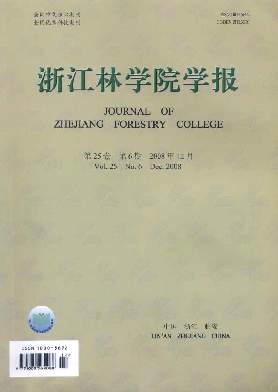Diurnal changes of photosynthesis and chlorophyll fluorescence in Cattleya × hybrida and Phalaenopsis amabilis with different light intensities
- Publish Date: 2008-12-20
-
Key words:
- botany /
- Cattleya × hybrida /
- Phalaenopsis amabilis /
- photosynthesis /
- parameters of chlorophyll fluorescence /
- photoinhibition
Abstract: Cattleya × hybrida and Phalaenopsis amabilis are popular for special flower and long florescence. We want to grasp the optimum illumination intensity for their cultivation. Diurnal changes in the rate of net photosynthesis (Pn) and parameters of chlorophyll fluorescence were studied with three light intensities:full light(no shading net,the most high light intensity was 860 μmol·m-2·s-1),36% of full light(with one layer of shading net,310 μmol·m-2·s-1) and 18% of full light(with two layers of shading net,160 μmol·m-2·s-1). The diurnal change were determined from 28th to 30th of September,2005 with three replications. The diurnal change in Pn for C. × hybrida and P. amabilis formed a“V”curve. From 10 a.m. onward to 6 p.m.,leaves in plants with full light and 36% of full light experienced negative photosynthesis. At 6 p.m.,Pn for full light intensity was still below 0,whereas the other two treatments were above 0. With 18% of full light intensity,compared to other two treatments,Pn decreased less at noon and recovered quicker. With full light intensity,variable fluorescence/maximum fluorescence (Fv/Fm) of dark-adapted material,Φ photosystem Ⅱ(ΦPSⅡ),and photochemical quenching (qP) decreased in the leaves with increasing light intensity,and were lower at 6 p.m. than at 8 a.m. Changes for Fv/Fm,ΦPSⅡ,and qP at 36% of full light intensity were nearly the same as full light intensity,but were closer at 6 p.m. and 8 a.m. With 18% of light intensity,chlorophyll fluorescence in C. × hybrida and P. amabilis was steady for the whole day. For 36% and 18% of full light intensity,the electron transfer rate increased with increasing light intensity,whereas the opposite occurred with full light intensity. Thus,C. × hybrida and P. amabilis suffered serious photoinhibition with light intensity of 500 μmol·m-2·s-1,but could endure with 310 μmol·m-2·s-1 light intensity with an optimum light intensity of about 160 μmol·m-2·s-1. [Ch,6 fig. 15 ref.]
| Citation: | WU Gen-liang, HE Yong, WANG Yong-chuan, et al. Diurnal changes of photosynthesis and chlorophyll fluorescence in Cattleya × hybrida and Phalaenopsis amabilis with different light intensities[J]. Journal of Zhejiang A&F University, 2008, 25(6): 733-738. |









 DownLoad:
DownLoad: